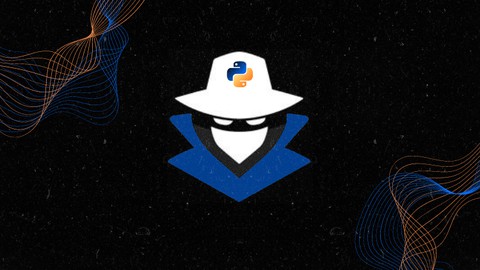
Ethical Hacking: Design Command and Control using Python 3
Ethical Hacking: Design Command and Control using Python 3, available at $54.99, has an average rating of 4.9, with 92 lectures, 9 quizzes, based on 10 reviews, and has 144 subscribers.
You will learn about Python coding and how to build a feature rich command and control tool that you can use for authorized cybersecurity tests, for fun, or for educational purposes How to code the client and server portions of the tool and enable them to interact with each other How to run the client code on target computers that do not have Python installed How to build the client code for either Windows or Linux operating systems How to implement AES encryption for all traffic between client and server How to implement the following features in your tool: reverse shell, key logging, screen captures, clipboard stealing, turning volume up, playing audio files And more features: displaying images, upload/download of files, zip/encrypt of files, unzip/decrypt of files And more features: running operating system commands in the background, flipping computer's screen upside down, typing on the compromised computer How to allow for multiple compromised computers to communicate to the c2 server and switch control over them Numerous Python concepts and terminology; every line or block of code is explained How to use Wireshark, Windows Subsystem for Linux (WSL), Ubuntu Linux, and PyCharm Community Edition Integrated Development Environment (IDE) How to operate the c2 server in a cloud, and more This course is ideal for individuals who are Ideally, it is for those that have some basic knowledge in at least one programming language and has an interest or experience in ethical hacking/offensive cybersecurity and would like to learn how to build their own tools. However, I start at ground zero and explain every line or block of code, thus beginners can follow along and learn too. Full source code is available within the course, which allows those that do not care about learning the Python or those that already know Python to skip most of the lessons if they prefer, but still be able to use the code. It is particularly useful for Ideally, it is for those that have some basic knowledge in at least one programming language and has an interest or experience in ethical hacking/offensive cybersecurity and would like to learn how to build their own tools. However, I start at ground zero and explain every line or block of code, thus beginners can follow along and learn too. Full source code is available within the course, which allows those that do not care about learning the Python or those that already know Python to skip most of the lessons if they prefer, but still be able to use the code.
Enroll now: Ethical Hacking: Design Command and Control using Python 3
Summary
Title: Ethical Hacking: Design Command and Control using Python 3
Price: $54.99
Average Rating: 4.9
Number of Lectures: 92
Number of Quizzes: 9
Number of Published Lectures: 92
Number of Published Quizzes: 9
Number of Curriculum Items: 101
Number of Published Curriculum Objects: 101
Original Price: $109.99
Quality Status: approved
Status: Live
What You Will Learn
- Python coding and how to build a feature rich command and control tool that you can use for authorized cybersecurity tests, for fun, or for educational purposes
- How to code the client and server portions of the tool and enable them to interact with each other
- How to run the client code on target computers that do not have Python installed
- How to build the client code for either Windows or Linux operating systems
- How to implement AES encryption for all traffic between client and server
- How to implement the following features in your tool: reverse shell, key logging, screen captures, clipboard stealing, turning volume up, playing audio files
- And more features: displaying images, upload/download of files, zip/encrypt of files, unzip/decrypt of files
- And more features: running operating system commands in the background, flipping computer's screen upside down, typing on the compromised computer
- How to allow for multiple compromised computers to communicate to the c2 server and switch control over them
- Numerous Python concepts and terminology; every line or block of code is explained
- How to use Wireshark, Windows Subsystem for Linux (WSL), Ubuntu Linux, and PyCharm Community Edition Integrated Development Environment (IDE)
- How to operate the c2 server in a cloud, and more
Who Should Attend
- Ideally, it is for those that have some basic knowledge in at least one programming language and has an interest or experience in ethical hacking/offensive cybersecurity and would like to learn how to build their own tools. However, I start at ground zero and explain every line or block of code, thus beginners can follow along and learn too. Full source code is available within the course, which allows those that do not care about learning the Python or those that already know Python to skip most of the lessons if they prefer, but still be able to use the code.
Target Audiences
- Ideally, it is for those that have some basic knowledge in at least one programming language and has an interest or experience in ethical hacking/offensive cybersecurity and would like to learn how to build their own tools. However, I start at ground zero and explain every line or block of code, thus beginners can follow along and learn too. Full source code is available within the course, which allows those that do not care about learning the Python or those that already know Python to skip most of the lessons if they prefer, but still be able to use the code.
Greetings course seekers. My course, “Ethical Hacking: Design Command and Control using Python 3” is hot off the press here in 2024. The way this course works is as follows:
I will start at ground zero and show you how to design and build a fully featured command and control tool using Python 3. I will take the time to explain to you every bit of the code that I use to make this project happen. This is a project that I accomplished myself a couple of years ago, but during my recording sessions for this class, I decided to re-do the code quite a bit, to make it better, and thus, you will get a live and realistic experience, because when bugs show up, they are new for me just as they are for you. I will record for you how I handle these situations and hopefully you can learn from this process.
I will show you how I started the project with a very humble beginning with a small little w3schools search, but then gradually expanded the code, turning it into a fully featured command and control tool over time, including both a client and server portion with many custom commands built in and with full end to end symmetric encryption.
I will move slowly and try to explain everything to you, including the Python code and best practices. I am not trying to rush through anything here with you. I really do want you to learn. However, if you are looking for contrived exercises to do and those sorts of things, this is not the course for that. I am showing you real code for a real Red Team tool that will have real application for you, if you work in or have an interest in Cybersecurity or Ethical Hacking.
The way this course will progress is that we will build the tool together starting from just a couple of lines of code. During every video, I am always using the term “we” because I expect you to be following along with me every step of the way. I will also provide you with 100% of the source codeafter each lesson, and the final state of the code at the end of the course. My code will become your code and you can take the tool to the next level, although it will be at a prominent level already.
The course is divided up into sections with each video building upon the last. At the end of each section, I always do a Python summary review that speaks directly to the new Python code we covered during a section of the course. Some of you that have Python experience may want to skip these videos, but for beginners or for those who are rusty, I recommend watching them.
The entire course is just over 18 hours in length and unlike other courses that cover many different topics and speed through everything, that is not what happens here. This course covers one topic, or you might consider it to be two topics and that is it. We have the command-and-control tool itself and we have the Python code that is building the tool. That is where all my energy and time will be directed, and this allows you to focus and learn.
My goal is that my course here will be a spark that some of you need to start building your own tools, or to make this tool even better. Learning is easy and fun when you have an interest in something, thus if you have that interest, give my course a try. If you do not care about coding your own custom tools for ethical hacking, then this course is not going to be the right fit for you.
Enough reading already! Go watch a few of my free preview videos and see what you think.
Course Curriculum
Chapter 1: Course Introduction
Lecture 1: Introduction
Lecture 2: Disclaimer
Lecture 3: Why use Python?
Chapter 2: Installations
Lecture 1: Setup Overview
Lecture 2: Installing Python 3.x
Lecture 3: Installing PyCharm Community Edition
Lecture 4: Installing and using Windows Subsystem for Linux
Lecture 5: Amazon Web Services (AWS) Ubuntu Elastic Compute Cloud (EC2) setup
Lecture 6: Installing and configuring PuTTY
Lecture 7: Installing Wireshark
Chapter 3: Client Code Beginnings
Lecture 1: Begin project and client code
Lecture 2: Obtaining request headers
Lecture 3: Changing request headers
Lecture 4: Adding a proxy option
Chapter 4: Server Code Beginnings
Lecture 1: Begin server code, part 1
Lecture 2: Begin server code, part 2
Lecture 3: Changing server versions
Lecture 4: Identifying Windows compromise
Lecture 5: Override log_request method
Lecture 6: Identifying Linux compromise
Lecture 7: Exception handling for getenv
Lecture 8: Python Summary 1
Chapter 5: Command Code Beginnings
Lecture 1: Begin command code
Lecture 2: Exception handling for get
Lecture 3: Sending command to client
Lecture 4: Running command on client
Lecture 5: Sending command output to server, part 1
Lecture 6: Sending command output to server, part 2
Lecture 7: Creating a settings module and Linux test
Lecture 8: Python Summary 2
Chapter 6: Begin Adding Features
Lecture 1: Adding change directory functionality
Lecture 2: Exception handling of change directory
Lecture 3: Fixing incorrect prompt and blank command
Lecture 4: Fixing broken pipe and getting new active client
Lecture 5: Placing current working directory in prompt
Lecture 6: Client kill and client sleep commands
Lecture 7: Implementing an input timeout
Lecture 8: Getting new active session at client kill command
Lecture 9: Python Summary 3
Chapter 7: Implementing Encryption
Lecture 1: Implementing symmetric encryption, part 1
Lecture 2: Implementing symmetric encryption, part 2
Lecture 3: Implementing symmetric encryption, part 3
Lecture 4: Implementing symmetric encryption, part 4
Lecture 5: Python summary 4 and type hinting
Chapter 8: File Related Features
Lecture 1: Client download file command – client code
Lecture 2: Client download file command – server code
Lecture 3: Client upload file command, part 1
Lecture 4: Client upload file command, part 2
Lecture 5: Client zip file command
Lecture 6: Code refactoring and fixing slash issue
Lecture 7: Client unzip file command
Lecture 8: Testing our code
Lecture 9: Fixing spaces in filenames and resetting prompt
Lecture 10: Python Summary 5
Chapter 9: Server Commands
Lecture 1: Implementing threading for the c2 server
Lecture 2: Server show clients command
Lecture 3: Server control pwned_id command and server exit command
Lecture 4: Server unzip filename command
Lecture 5: Server zip filename command and improving exceptions
Lecture 6: Server list directory and server shell commands
Lecture 7: Server help command and logging
Lecture 8: Respond to GET after server commands
Lecture 9: Python Summary 6
Chapter 10: Client Commands
Lecture 1: Client delay seconds command
Lecture 2: Client get clipboard command
Lecture 3: Client keylog on and client keylog off commands
Lecture 4: Client type text command
Lecture 5: Client screenshot command
Lecture 6: Client display image command and get_filename bug fix
Lecture 7: Client flip screen and roll screen commands
Lecture 8: Client max volume and client play filename commands
Lecture 9: Implementing client background jobs feature
Lecture 10: Adding more Try/Except Statements to our code
Lecture 11: Python Summary 7
Chapter 11: Finalizing Code and Testing
Lecture 1: Separating Linux and Windows client code
Lecture 2: Linux to Linux test results and bug fixes
Lecture 3: Shebang and other Linux details
Lecture 4: How to test on your computer and final test results
Lecture 5: Packaging Windows client with Pyinstaller
Lecture 6: Packaging Linux client with Pyinstaller
Lecture 7: Packaging everything as a single folder
Instructors
-

Bill Reed
Cyber Threat Emulation / Red Team Operator
Rating Distribution
- 1 stars: 0 votes
- 2 stars: 0 votes
- 3 stars: 0 votes
- 4 stars: 2 votes
- 5 stars: 8 votes
Frequently Asked Questions
How long do I have access to the course materials?
You can view and review the lecture materials indefinitely, like an on-demand channel.
Can I take my courses with me wherever I go?
Definitely! If you have an internet connection, courses on Udemy are available on any device at any time. If you don’t have an internet connection, some instructors also let their students download course lectures. That’s up to the instructor though, so make sure you get on their good side!
You may also like
- Digital Marketing Foundation Course
- Google Shopping Ads Digital Marketing Course
- Multi Cloud Infrastructure for beginners
- Master Lead Generation: Grow Subscribers & Sales with Popups
- Complete Copywriting System : write to sell with ease
- Product Positioning Masterclass: Unlock Market Traction
- How to Promote Your Webinar and Get More Attendees?
- Digital Marketing Courses
- Create music with Artificial Intelligence in this new market
- Create CONVERTING UGC Content So Brands Will Pay You More
- Podcast: The top 8 ways to monetize by Podcasting
- TikTok Marketing Mastery: Learn to Grow & Go Viral
- Free Digital Marketing Basics Course in Hindi
- MailChimp Free Mailing Lists: MailChimp Email Marketing
- Automate Digital Marketing & Social Media with Generative AI
- Google Ads MasterClass – All Advanced Features
- Online Course Creator: Create & Sell Online Courses Today!
- Introduction to SEO – Basic Principles of SEO
- Affiliate Marketing For Beginners: Go From Novice To Pro
- Effective Website Planning Made Simple




















